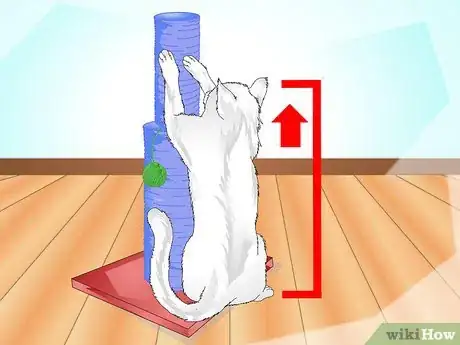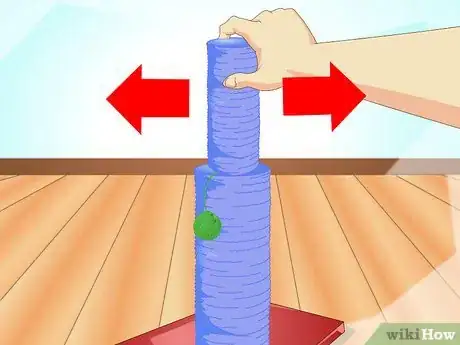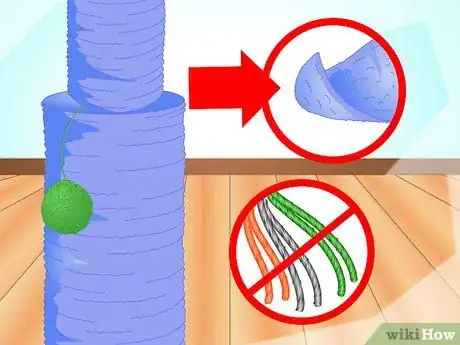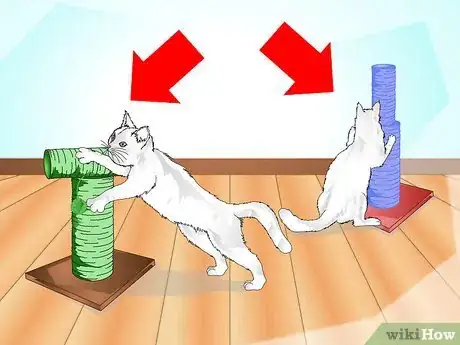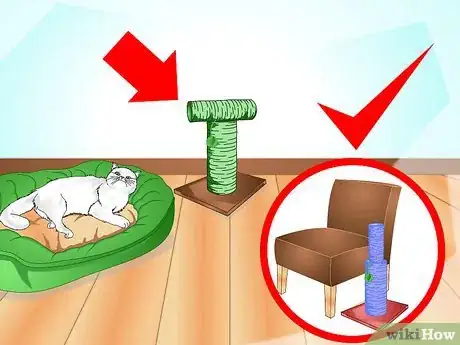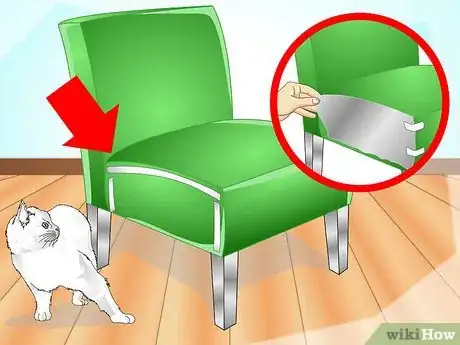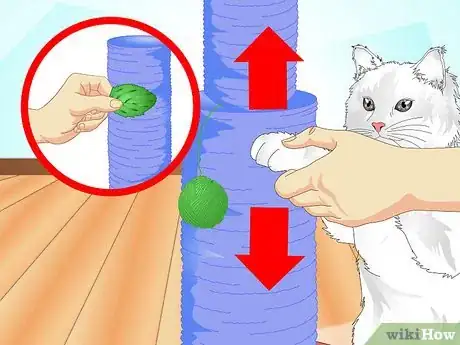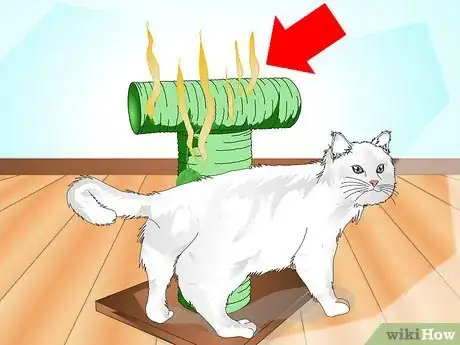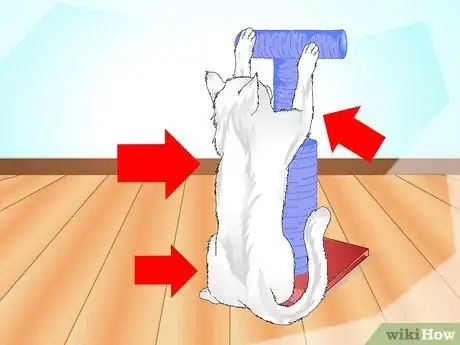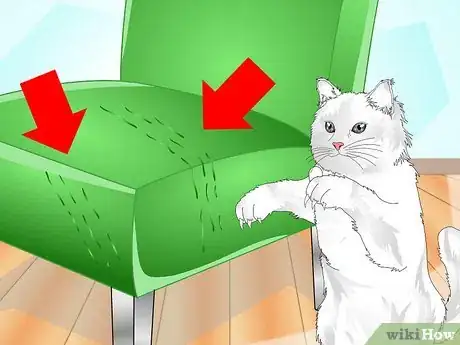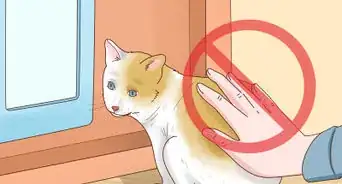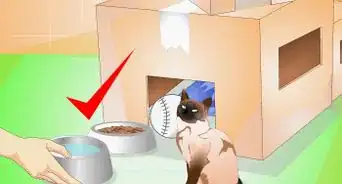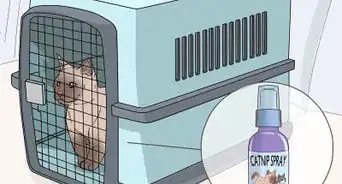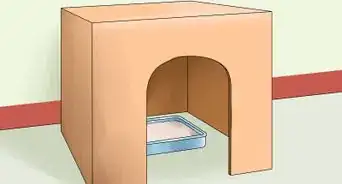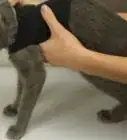This article was co-authored by Molly DeVoss. Molly DeVoss is a Certified Feline Training and Behavior Specialist (CFTBS), a Certified Cat Behavior Consultant (CCBC), a Fear Free Certified Trainer (FFCT), and the Founder of Cat Behavior Solutions. Molly specializes in using positive reinforcement to modify and prevent unwanted behaviors in cats and reduce cat shelter surrender. Molly has sat on the Dallas Animal Advisory committee since 2013 and was voted one of the Top 12 Extraordinary Cat Behaviorists of 2020 by Catpetclub.com. She is certified by both the Animal Behavior Institute and the International Association of Animal Behavior Consultants. She is also the host of the weekly podcast Cat Talk Radio.
wikiHow marks an article as reader-approved once it receives enough positive feedback. In this case, 88% of readers who voted found the article helpful, earning it our reader-approved status.
This article has been viewed 160,981 times.
Cats like to scratch things with their front paws. Scratching is instinctive behavior that helps a cat spread his or her scent. Scratching is also an important way of marking territory, which makes cats feel secure. However, when your cat decides to scratch your new sofa or a piece of antique furniture, this behavior becomes a problem. The best solution is to redirect your cat’s behavior to a scratching post. Your cat may not be interested in the post at first, but there are several things you can do to get your cat to use the scratching posts you provide.[1]
Steps
Choosing a Cat Scratching Post
-
1Choose a scratching post that is tall. Cats need to be able to reach up as high as they can to scratch and stretch. If the scratching post is too short, your cat may not even look at it. The post should be high enough to allow your cat to stand on her back legs and reach above her head with her front paws.[2]
-
2Make sure the post is stable. To make sure your cat’s scratching post is stable, try fixing it to a surface or making sure the post has a sturdy base so it won’t budge when the cat scratches it. If your cat feels the post move or shift, she won't feel secure and may refuse to use the post.
- Scratching boards which you lean against a wall or hang like a picture are unpopular with most cats.
Advertisement -
3Select a texture that your cat will like. Individual cats favor different textures to scratch on. If you are not sure what your cat likes, a good starter scratcher is natural rope wound around a sturdy column.[3]
- Avoid plastic ropes or artificial fibers because these materials can create static, which cats dislike.
- If your cat likes to scratch carpet, then consider nailing a piece of carpet to a sturdy post.
- Other textures to consider trying include corrugated cardboard, and cloth.
-
4Get more than one post. Chances are that your cat likes to scratch in more than just one spot, so plan to purchase or create more than one scratching post in your house. Having multiple posts will ensure that your cat always has access to a scratching post where ever she is. Having multiple posts is even more important if you have multiple cats.
- If you have multiple cats, each cat should have its own post.[4]
Getting Your Cat to Use Scratching Posts
-
1Place the posts somewhere that your cat can access them with ease. For maximum use, place the posts where the cat is going to get "value" from using it as a territory marker. Good places for a scratching posts include near entrances or exits, near a window, or in front of an object she already favors as a scratching post.
- Place your scratching post next to places you don't want your cat to scratch.[5]
- Do NOT place the post in an inconspicuous, out of the way place. Your cat will ignore it.
- Make sure that the post is positioned in a way that your cat likes to scratch. For example, if your cat prefers to scratch vertical surfaces, like the side of the sofa, make sure that the post is in a vertical position.
- Cats often like to scratch after waking up, so place a scratching post near your cat’s favorite napping spot as well.[6]
- If you're fostering kittens or cats, place a scratching post on either side of the barrier door. This way, your cats have a place to release pent-up territorial energy.[7]
-
2Make your cat’s favorite piece of furniture unappealing. If your cat likes to scratch furniture, consider wrapping the part she likes to scratch in tin foil or double sided sticky tape. Cats hate the feel of tin foil and sticky surfaces so it should discourage your cat from scratching.[8]
- You can also cover the sofa with rugs, but this can be an imperfect solution because your cat may just start scratching the rugs.
-
3Make scratching posts more attractive to your cat. You can make scratching posts more attractive to your cat using her own scent or some catnip.[9] Try showing your cat how to use a post by rubbing her paws on it or rub some catnip into the scratching post to draw her attention to it. [10]
- Encourage your cat to use the post by making gentle scratching motions with her paws on the post. Doing so will help to add her scent to the post make her more likely to use it. Make sure that you praise your cat while you do this.
- Try spritzing the scratching post with Feliway.[11] Feliway is a synthetic feline pheromone that makes cats feel safe and secure. It also amplifies her scent signals, which she will appreciate.[12]
Understanding Why Cats Scratch
-
1Understand that cats communicate using scent. Cats have scent glands between their toes that leave behind a unique scent.[13] Cats often communicate by reading the smells around them.[14]
- A cat will scent mark her territory to let other cats know she is around, to tell other cats when she was last there, and to make herself feel safe and secure.
-
2Recognize that scratching is a form of stretching exercise for cats. Cats also scratch as a way to stretch their muscles. As cats scratch, they are stretching the muscles in their back and legs, which feels nice to them. It is similar to the way that we stretch in the morning or after sitting for a long time.[15]
-
3Be aware that cats often prefer to scratch surfaces that feel pleasant. Cats like to scratch surfaces that feel nice under their paws. That is why some cats will end up shredding a nice piece of furniture or an expensive rug. Scratching acts as a kind of stress reliever, so it is necessary for them to engage in it.[16]
- Try to provide a substitute scratcher with a similar texture to your cat's preferred scratching surface.
Expert Q&A
-
QuestionWhy are scratching posts good for cats?
 Molly DeVossMolly DeVoss is a Certified Feline Training and Behavior Specialist (CFTBS), a Certified Cat Behavior Consultant (CCBC), a Fear Free Certified Trainer (FFCT), and the Founder of Cat Behavior Solutions. Molly specializes in using positive reinforcement to modify and prevent unwanted behaviors in cats and reduce cat shelter surrender. Molly has sat on the Dallas Animal Advisory committee since 2013 and was voted one of the Top 12 Extraordinary Cat Behaviorists of 2020 by Catpetclub.com. She is certified by both the Animal Behavior Institute and the International Association of Animal Behavior Consultants. She is also the host of the weekly podcast Cat Talk Radio.
Molly DeVossMolly DeVoss is a Certified Feline Training and Behavior Specialist (CFTBS), a Certified Cat Behavior Consultant (CCBC), a Fear Free Certified Trainer (FFCT), and the Founder of Cat Behavior Solutions. Molly specializes in using positive reinforcement to modify and prevent unwanted behaviors in cats and reduce cat shelter surrender. Molly has sat on the Dallas Animal Advisory committee since 2013 and was voted one of the Top 12 Extraordinary Cat Behaviorists of 2020 by Catpetclub.com. She is certified by both the Animal Behavior Institute and the International Association of Animal Behavior Consultants. She is also the host of the weekly podcast Cat Talk Radio.
Certified Feline Training and Behavior Specialist & Certified Cat Behavior Consultant Certified Feline Training and Behavior Specialist & Certified Cat Behavior ConsultantExpert AnswerCats have scent glands between their toes—a scratching post lets your cats leave behind their signature scent, along with visual lines that potential invaders can see.
Certified Feline Training and Behavior Specialist & Certified Cat Behavior ConsultantExpert AnswerCats have scent glands between their toes—a scratching post lets your cats leave behind their signature scent, along with visual lines that potential invaders can see. -
QuestionWhere do you put a cat post?
 Molly DeVossMolly DeVoss is a Certified Feline Training and Behavior Specialist (CFTBS), a Certified Cat Behavior Consultant (CCBC), a Fear Free Certified Trainer (FFCT), and the Founder of Cat Behavior Solutions. Molly specializes in using positive reinforcement to modify and prevent unwanted behaviors in cats and reduce cat shelter surrender. Molly has sat on the Dallas Animal Advisory committee since 2013 and was voted one of the Top 12 Extraordinary Cat Behaviorists of 2020 by Catpetclub.com. She is certified by both the Animal Behavior Institute and the International Association of Animal Behavior Consultants. She is also the host of the weekly podcast Cat Talk Radio.
Molly DeVossMolly DeVoss is a Certified Feline Training and Behavior Specialist (CFTBS), a Certified Cat Behavior Consultant (CCBC), a Fear Free Certified Trainer (FFCT), and the Founder of Cat Behavior Solutions. Molly specializes in using positive reinforcement to modify and prevent unwanted behaviors in cats and reduce cat shelter surrender. Molly has sat on the Dallas Animal Advisory committee since 2013 and was voted one of the Top 12 Extraordinary Cat Behaviorists of 2020 by Catpetclub.com. She is certified by both the Animal Behavior Institute and the International Association of Animal Behavior Consultants. She is also the host of the weekly podcast Cat Talk Radio.
Certified Feline Training and Behavior Specialist & Certified Cat Behavior Consultant Certified Feline Training and Behavior Specialist & Certified Cat Behavior ConsultantExpert AnswerSet a tall scratching post right next to your kitty's bed, as cats tend to scratch right after taking a nap. You can also put your scratching post near spots you don't want your cat scratching up.
Certified Feline Training and Behavior Specialist & Certified Cat Behavior ConsultantExpert AnswerSet a tall scratching post right next to your kitty's bed, as cats tend to scratch right after taking a nap. You can also put your scratching post near spots you don't want your cat scratching up. -
QuestionHow do I attract my cat to a scratching post?
 Molly DeVossMolly DeVoss is a Certified Feline Training and Behavior Specialist (CFTBS), a Certified Cat Behavior Consultant (CCBC), a Fear Free Certified Trainer (FFCT), and the Founder of Cat Behavior Solutions. Molly specializes in using positive reinforcement to modify and prevent unwanted behaviors in cats and reduce cat shelter surrender. Molly has sat on the Dallas Animal Advisory committee since 2013 and was voted one of the Top 12 Extraordinary Cat Behaviorists of 2020 by Catpetclub.com. She is certified by both the Animal Behavior Institute and the International Association of Animal Behavior Consultants. She is also the host of the weekly podcast Cat Talk Radio.
Molly DeVossMolly DeVoss is a Certified Feline Training and Behavior Specialist (CFTBS), a Certified Cat Behavior Consultant (CCBC), a Fear Free Certified Trainer (FFCT), and the Founder of Cat Behavior Solutions. Molly specializes in using positive reinforcement to modify and prevent unwanted behaviors in cats and reduce cat shelter surrender. Molly has sat on the Dallas Animal Advisory committee since 2013 and was voted one of the Top 12 Extraordinary Cat Behaviorists of 2020 by Catpetclub.com. She is certified by both the Animal Behavior Institute and the International Association of Animal Behavior Consultants. She is also the host of the weekly podcast Cat Talk Radio.
Certified Feline Training and Behavior Specialist & Certified Cat Behavior Consultant Certified Feline Training and Behavior Specialist & Certified Cat Behavior ConsultantExpert AnswerSpritz it with Feliway's Feliscratch product, which has a pheromone attractant in it. You can also rub catnip over the post, or give your cat a reward when you notice them using it.
Certified Feline Training and Behavior Specialist & Certified Cat Behavior ConsultantExpert AnswerSpritz it with Feliway's Feliscratch product, which has a pheromone attractant in it. You can also rub catnip over the post, or give your cat a reward when you notice them using it.
References
- ↑ Beaver, B, (2003), Feline Behavior, ISBN 978-0721694986
- ↑ Molly DeVoss. Certified Feline Training and Behavior Specialist & Certified Cat Behavior Consultant. Expert Interview. 15 July 2021.
- ↑ http://www.hillspet.com/cat-care/indoor-cat-articles-start-scratching-right.html
- ↑ Molly DeVoss. Certified Feline Training and Behavior Specialist & Certified Cat Behavior Consultant. Expert Interview. 15 July 2021.
- ↑ Molly DeVoss. Certified Feline Training and Behavior Specialist & Certified Cat Behavior Consultant. Expert Interview. 15 July 2021.
- ↑ Molly DeVoss. Certified Feline Training and Behavior Specialist & Certified Cat Behavior Consultant. Expert Interview. 15 July 2021.
- ↑ Molly DeVoss. Certified Feline Training and Behavior Specialist & Certified Cat Behavior Consultant. Expert Interview. 15 July 2021.
- ↑ https://www.aspca.org/pet-care/virtual-pet-behaviorist/cat-behavior/destructive-scratching
- ↑ Molly DeVoss. Certified Feline Training and Behavior Specialist & Certified Cat Behavior Consultant. Expert Interview. 15 July 2021.
- ↑ Beaver, B, (2003), Feline Behavior, ISBN 978-0721694986
- ↑ Molly DeVoss. Certified Feline Training and Behavior Specialist & Certified Cat Behavior Consultant. Expert Interview. 15 July 2021.
- ↑ Beaver, B, (2003), Feline Behavior, ISBN 978-0721694986
- ↑ Molly DeVoss. Certified Feline Training and Behavior Specialist & Certified Cat Behavior Consultant. Expert Interview. 15 July 2021.
- ↑ Beaver, B, (2003), Feline Behavior, ISBN 978-0721694986
- ↑ http://www.catbehaviorassociates.com/furniture-scratching/
- ↑ http://www.catbehaviorassociates.com/furniture-scratching/
About This Article
To get your cat to use a scratching post, try rubbing some catnip on it to make it more enticing. You can also try taking your cat's paws and making gentle scratching motions with them on the post, which will add your cat's scent to the post and make it more likely to use it. Make sure the post is easily accessible by placing it near your cat's bed, in front of a window, or next to furniture that your cat enjoys scratching. Also, check that the post is sturdy since cat's don't like to scratch things that aren't stable. To learn how to stop your cat from scratching things it's not supposed to, keep reading!
